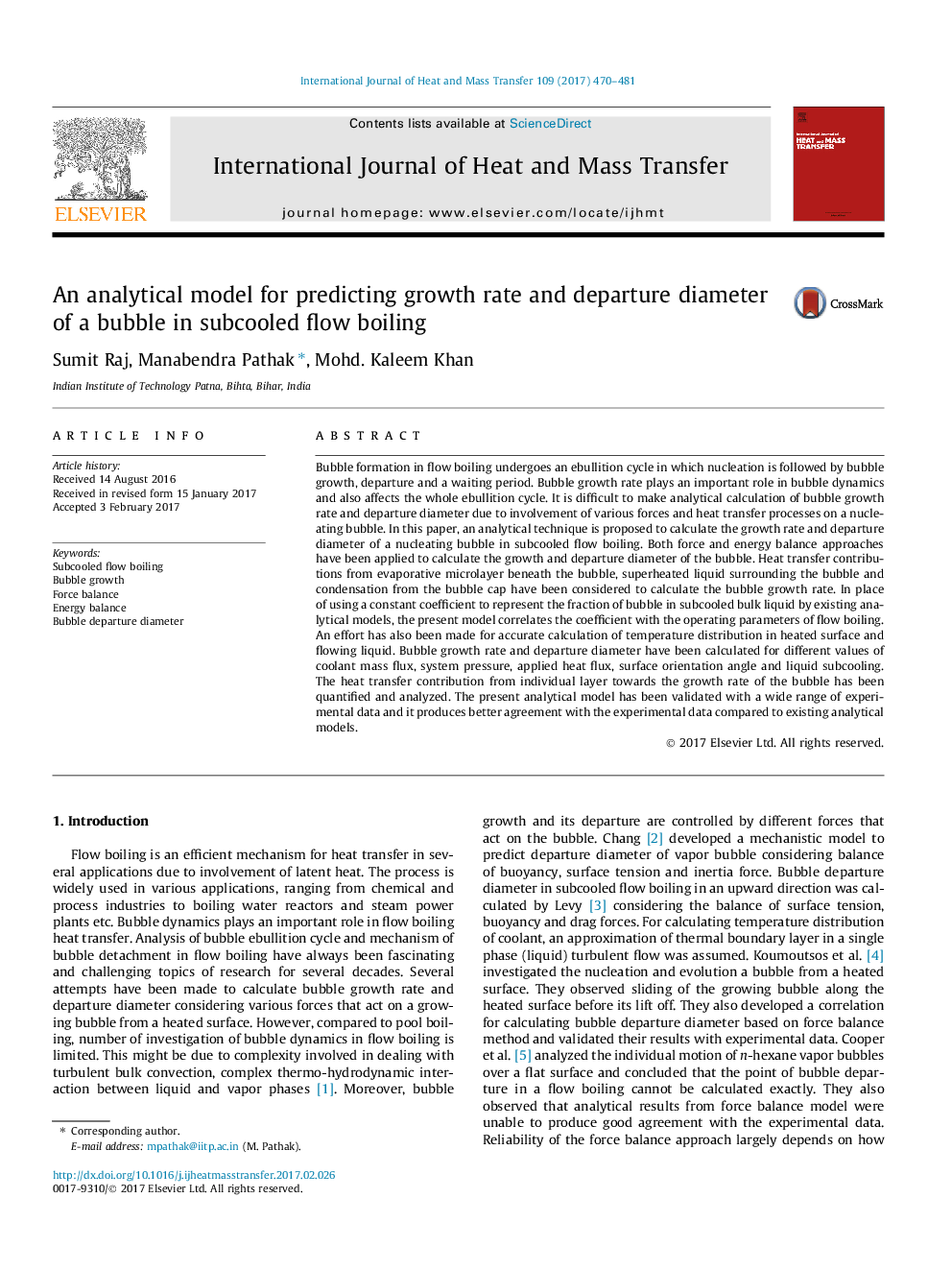| کد مقاله | کد نشریه | سال انتشار | مقاله انگلیسی | نسخه تمام متن |
|---|---|---|---|---|
| 4994503 | 1458032 | 2017 | 12 صفحه PDF | دانلود رایگان |
عنوان انگلیسی مقاله ISI
An analytical model for predicting growth rate and departure diameter of a bubble in subcooled flow boiling
ترجمه فارسی عنوان
یک مدل تحلیلی برای پیش بینی سرعت رشد و قطر خروجی یک حباب در جریان جوش شیرین
دانلود مقاله + سفارش ترجمه
دانلود مقاله ISI انگلیسی
رایگان برای ایرانیان
کلمات کلیدی
جریان جوش زیرآبی، رشد حباب، تعادل نیروی تعادل انرژی، قطر خروج حباب،
ترجمه چکیده
شکل گیری حباب در جوش جوش یک چرخه ایبولیتیک دارد که در آن هسته شدن به دنبال رشد حباب، خروج و یک دوره انتظار است. سرعت رشد حباب نقش مهمی در دینامیک حباب بازی می کند و همچنین در کل چرخه ایوبالیتی تاثیر می گذارد. محاسبه تحلیلی نرخ رشد حباب و قطر خروجی به دلیل دخالت نیروهای مختلف و فرآیندهای انتقال حرارت در یک حباب هسته ای دشوار است. در این مقاله، یک روش تحلیلی برای محاسبه سرعت رشد و قطر خروجی یک حباب هسته ای در جریان جوش جوش شیرین پیشنهاد شده است. رویکردهای تعادل نیروی و انرژی برای محاسبه قطر رشد و خروج حباب اعمال شده است. کمک های انتقال حرارت از میکرولیای تبخیری زیر حباب، مایع سوپر تبخیر اطراف حباب و تراکم از کلاهک حباب برای محاسبه نرخ رشد حباب درنظر گرفته شده است. به جای استفاده از یک ضریب ثابت برای نشان دادن کسری از حباب در مایع تخلخل بیرونی با استفاده از مدل های تحلیلی موجود، مدل حاضر، ضریب پارامترهای جریان جوش را با هم مرتبط می کند. همچنین تلاش برای محاسبه دقیق توزیع دما در سطح گرم و جریان مایع صورت گرفته است. نرخ رشد حباب و قطر خروجی برای مقادیر مختلف شار جرم خنک کننده، فشار سیستم، شار حرارتی اعمال شده، زاویه جهت جهت و غلظت مایع محاسبه شده است. سهم انتقال گرما از لایه فرد به سمت نرخ رشد حباب اندازه گیری شده و تجزیه و تحلیل شده است. مدل تحلیلی حاضر با طیف وسیعی از داده های تجربی معتبر بوده و توافق بهتر با داده های تجربی را نسبت به مدل های تحلیلی موجود ارائه می دهد.
موضوعات مرتبط
مهندسی و علوم پایه
مهندسی شیمی
جریان سیال و فرایندهای انتقال
چکیده انگلیسی
Bubble formation in flow boiling undergoes an ebullition cycle in which nucleation is followed by bubble growth, departure and a waiting period. Bubble growth rate plays an important role in bubble dynamics and also affects the whole ebullition cycle. It is difficult to make analytical calculation of bubble growth rate and departure diameter due to involvement of various forces and heat transfer processes on a nucleating bubble. In this paper, an analytical technique is proposed to calculate the growth rate and departure diameter of a nucleating bubble in subcooled flow boiling. Both force and energy balance approaches have been applied to calculate the growth and departure diameter of the bubble. Heat transfer contributions from evaporative microlayer beneath the bubble, superheated liquid surrounding the bubble and condensation from the bubble cap have been considered to calculate the bubble growth rate. In place of using a constant coefficient to represent the fraction of bubble in subcooled bulk liquid by existing analytical models, the present model correlates the coefficient with the operating parameters of flow boiling. An effort has also been made for accurate calculation of temperature distribution in heated surface and flowing liquid. Bubble growth rate and departure diameter have been calculated for different values of coolant mass flux, system pressure, applied heat flux, surface orientation angle and liquid subcooling. The heat transfer contribution from individual layer towards the growth rate of the bubble has been quantified and analyzed. The present analytical model has been validated with a wide range of experimental data and it produces better agreement with the experimental data compared to existing analytical models.
ناشر
Database: Elsevier - ScienceDirect (ساینس دایرکت)
Journal: International Journal of Heat and Mass Transfer - Volume 109, June 2017, Pages 470-481
Journal: International Journal of Heat and Mass Transfer - Volume 109, June 2017, Pages 470-481
نویسندگان
Sumit Raj, Manabendra Pathak, Mohd. Kaleem Khan,
